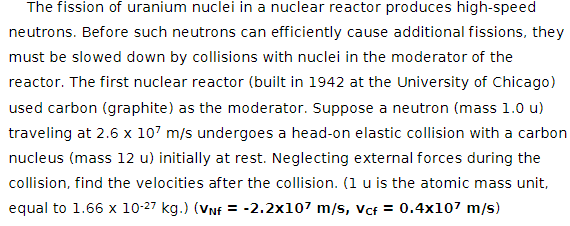The fission of uranium nuclei in a nuclear reactor produces high-speed neutrons. Before such neutrons can efficiently cause additional fissions, they must be slowed down by collisions with nuclei in the moderator of the reactor. The first nuclear reactor (built in 1942 at the University of Chicago) used carbon (graphite) as the moderator. Suppose a neutron (mass 1.0 u) traveling at 2.6 x 107 m/s undergoes a head-on elastic collision with a carbon nucleus (mass 12 u) initially at rest. Neglecting external forces during the collision, find the velocities after the collision. (1 u is the atomic mass unit, equal to 1.66 x 10-27 kg.) (VNF = -2.2x107 m/s, vcf = 0.4x107 m/s)
The fission of uranium nuclei in a nuclear reactor produces high-speed neutrons. Before such neutrons can efficiently cause additional fissions, they must be slowed down by collisions with nuclei in the moderator of the reactor. The first nuclear reactor (built in 1942 at the University of Chicago) used carbon (graphite) as the moderator. Suppose a neutron (mass 1.0 u) traveling at 2.6 x 107 m/s undergoes a head-on elastic collision with a carbon nucleus (mass 12 u) initially at rest. Neglecting external forces during the collision, find the velocities after the collision. (1 u is the atomic mass unit, equal to 1.66 x 10-27 kg.) (VNF = -2.2x107 m/s, vcf = 0.4x107 m/s)
Principles of Physics: A Calculus-Based Text
5th Edition
ISBN:9781133104261
Author:Raymond A. Serway, John W. Jewett
Publisher:Raymond A. Serway, John W. Jewett
Chapter8: Momentum And Collisions
Section: Chapter Questions
Problem 61P
Related questions
Question

Transcribed Image Text:The fission of uranium nuclei in a nuclear reactor produces high-speed
neutrons. Before such neutrons can efficiently cause additional fissions, they
must be slowed down by collisions with nuclei in the moderator of the
reactor. The first nuclear reactor (built in 1942 at the University of Chicago)
used carbon (graphite) as the moderator. Suppose a neutron (mass 1.0 u)
traveling at 2.6 x 107 m/s undergoes a head-on elastic collision with a carbon
nucleus (mass 12 u) initially at rest. Neglecting external forces during the
collision, find the velocities after the collision. (1 u is the atomic mass unit,
equal to 1.66 x 10-27 kg.) (VNF = -2.2x107 m/s, vcf = 0.4x107 m/s)
Expert Solution
This question has been solved!
Explore an expertly crafted, step-by-step solution for a thorough understanding of key concepts.
This is a popular solution!
Trending now
This is a popular solution!
Step by step
Solved in 2 steps with 1 images

Recommended textbooks for you

Principles of Physics: A Calculus-Based Text
Physics
ISBN:
9781133104261
Author:
Raymond A. Serway, John W. Jewett
Publisher:
Cengage Learning

University Physics Volume 1
Physics
ISBN:
9781938168277
Author:
William Moebs, Samuel J. Ling, Jeff Sanny
Publisher:
OpenStax - Rice University

Physics for Scientists and Engineers: Foundations…
Physics
ISBN:
9781133939146
Author:
Katz, Debora M.
Publisher:
Cengage Learning

Principles of Physics: A Calculus-Based Text
Physics
ISBN:
9781133104261
Author:
Raymond A. Serway, John W. Jewett
Publisher:
Cengage Learning

University Physics Volume 1
Physics
ISBN:
9781938168277
Author:
William Moebs, Samuel J. Ling, Jeff Sanny
Publisher:
OpenStax - Rice University

Physics for Scientists and Engineers: Foundations…
Physics
ISBN:
9781133939146
Author:
Katz, Debora M.
Publisher:
Cengage Learning

Physics for Scientists and Engineers, Technology …
Physics
ISBN:
9781305116399
Author:
Raymond A. Serway, John W. Jewett
Publisher:
Cengage Learning

Classical Dynamics of Particles and Systems
Physics
ISBN:
9780534408961
Author:
Stephen T. Thornton, Jerry B. Marion
Publisher:
Cengage Learning

College Physics
Physics
ISBN:
9781285737027
Author:
Raymond A. Serway, Chris Vuille
Publisher:
Cengage Learning